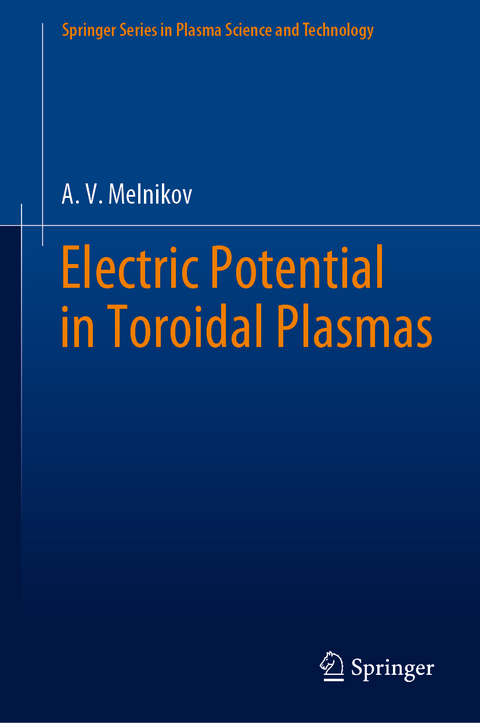
Electric Potential in Toroidal Plasmas
Springer International Publishing (Verlag)
978-3-030-03480-1 (ISBN)
This work introduces heavy ion beam probe diagnostics and presents an overview of its applications. The heavy ion beam probe is a unique tool for the measurement of potential in the plasma core in order to understand the role of the electric field in plasma confinement, including the mechanism of transition from low to high confinement regimes (L-H transition). This allows measurement of the steady-state profile of the plasma potential, and its use has been extended to include the measurement of quasi-monochromatic and broadband oscillating components, the turbulent-particle flux and oscillations of the electron density and poloidal magnetic field.
Special emphasis is placed on the study of Geodesic Acoustic Modes and Alfvén Eigenmodes excited by energetic particles with experimental data sets. These experimental studies help to understand the link between broadband turbulent physics and quasi-coherent oscillations in devices with a rather different magnetic configuration.
Thebook also compares spontaneous and biased transitions from low to high confinement regimes on both classes of closed magnetic traps (tokamak and stellarator) and highlights the common features in the behavior of electric potential and turbulence of magnetized plasmas.
A valuable resource for physicists, postgraduates and students specializing in plasma physics and controlled fusion.
Alexander Vladimirovich Melnikov, born in 1960 in Moscow, USSR, studied at Lomonosov Moscow State University, from 1977 and graduated in 1982 with distinguished Master diploma. In 1987 he received his PhD in applied mathematics with his thesis on mathematical aspects of fusion plasma diagnostics – Heavy Ion Beam Probing (HIBP). In 1982 he had already started as a research engineer in Tokamak division, National Research Centre (NRC) ‘Kurchatov Institute’ in Moscow - Russia’s national leading scientific center and birthplace of tokamaks. He worked in the TM-4 tokamak, and later in the T-10 tokamak, focusing on plasma electric potential studies and HIBP development in collaboration with the HIBP group from Ukrainian National Science Centre ‘Kharkov Institute of Physics and Technology’ (NSC KIPT), led by Dr. Ludmila Krupnik. In 1984 he got a position as junior researcher, in 1988 as researcher, and in 1992 as senior researcher. In 1992 he started a trilateral scientific collaboration between NRC ‘Kurchatov Institute’, NSC KIPT and “Centro de Investigaciones Energeticas, Medioambientales and Technologicas” (CIEMAT), Madrid, Spain, which successfully remains up to now. In 1993 he established and led the HIBP research group at the NRC ‘Kurchatov Institute’. In 1994 he got a position of leading researcher, and in 2016 of deputy head of the Tokamak Division in Fusion Research Centre. In 2012 he received the degree of Dr.Sci. in plasma physics with his thesis “Electric Potential in Toroidal Plasma Devices”. In that same year he became a member of the Expert Group on the Energetic particle physics of the International Tokamak Physics Activity in support of ITER. Since 1993 he is an Associate Professor, and since 2014 a Full Professor at the National Nuclear Research University ‘Moscow Engineering and Physical Institute’ (MEPhI, Moscow), teaching the course ‘Technology of thermonuclear experiment’ to Master students. Author of more than 300 papers on plasma physics and plasma diagnostics, he published a monograph ‘Electric Potential in Toroidal Plasma Devices’ in Russian in 2015. In 1983 he received the Kurchatov award for the best scientific work of young scientists, and in 2008, 2011 and 2015 the Kurchatov awards for the best scientific work by NRC “Kurchatov Institute”. In 2016 he got Artsimovich award for the outstanding work in experimental physics by Russian Academy of Science.
Foreword by S.E. Lysenko.- Preface by A.V. Melnikov.- List of Abbreviations.- Frequently Used Symbols.- Introduction.- The Heavy Ion Beam Probe Diagnostic and Applications.- Radial Profiles of the Plasma Potential in Ohmic Regimes and L-mode Plasmas.- Characterization of the Quasicoherent Oscillations in the Plasma Potential.- Evolution of the Plasma Potential during Transitions to Improved Confinement Modes.- Conclusions.
| Erscheinungsdatum | 06.01.2019 |
|---|---|
| Reihe/Serie | Springer Series in Plasma Science and Technology |
| Zusatzinfo | XV, 240 p. 202 illus., 194 illus. in color. |
| Verlagsort | Cham |
| Sprache | englisch |
| Original-Titel | Electric Potential in Toroidal Plasmas |
| Maße | 155 x 235 mm |
| Gewicht | 549 g |
| Themenwelt | Naturwissenschaften ► Physik / Astronomie ► Plasmaphysik |
| Naturwissenschaften ► Physik / Astronomie ► Theoretische Physik | |
| Schlagworte | Alfven Eigenmodes • Electric potential in tokamak • Heavy Ion Beam Probing • High confinement H-mode • Low confinement L-mode • MHD simulation • T-10 tokamak • TJ-II stellarator |
| ISBN-10 | 3-030-03480-1 / 3030034801 |
| ISBN-13 | 978-3-030-03480-1 / 9783030034801 |
| Zustand | Neuware |
| Informationen gemäß Produktsicherheitsverordnung (GPSR) | |
| Haben Sie eine Frage zum Produkt? |
aus dem Bereich

